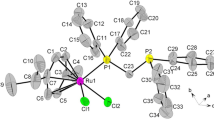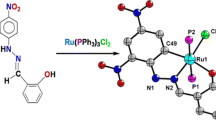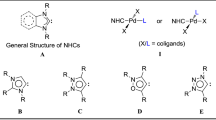Summary
A SiO2 supported Rh(I) catalyst of trisulfonated triphenylphosphine catalyzes the addition of diphenylacetylene to azobenzene in refluxing butanol in the presence of triphenylphosphine to afford N-anilino-2,3-diphenylindole and 2,3-diphenylindole with turnover numbers of 80 and 20, respectively. As compared to the known homogeneous or heterogeneous (SiO2) catalysis by RhCl(PPh3)3, the supported aqueous phase system retains a constant turnover frequency throughout the reaction and can be partially recycled.
Zusammenfassung
Ein auf SiO2 aufgebrachter Rh(I)-Katalysator aus trisulfoniertem Triphenylphosphin katalysiert die Addition von Diphenylacetylen an Azobenzol in siedendem Butanol in Gegenwart von Triphenylphosphin. Es entstehen N-Anilino-2,3-diphenylindol und 2,3-Diphenylindol. Die Umsatzzahlen betragen 80 bzw. 20. Verglichen mit den bekannten Methoden der homogenen oder heterogenen (SiO2) Katalyse durch RhCl(PPh3)3 erhält der Katalysator auf Trägermaterial während der gesamten Reaktionsdauer einen konstanten Umsatz aufrecht und kann teilweise wiedergewonnen werden.
Similar content being viewed by others
References
For number XXXV, see Ref. [8];
Keim W (1984) Chem Ing Techn56: 850
Herrmann WA (1992) Hoechst High Chem Magazin Nr.13: 24
Herrmann WA, Kohlpaintner C (1993) Angew Chem105: 1588; (1993) Int Ed Engl32: 1524
Kuntz EG (1987) CHEMTECH17: 570
Arhancet JP, Davis ME, Merola JS, Hanson BE (1989) Nature339: 454
Fremy G, Monflier E, Carpentier J-F, Castanet Y, Mortreux A (1995) Angew Chem107: 1608; (1995) Int Ed Engl34: 1474
Reißer P, Wakatsuki Y, Kisch H (1995) Monatsh Chem126: 1
Melchinger U, Aulwurm U, Kisch H (1995) Organometallics14: 3385
Cornils B (1995) Angew Chem107: 1709; (1995) Int Ed Engl34: 1574
Alario F, Amrani Y, Colleuille Y, Dang TP, Jenck J, Morel D, Sinou D (1986) J Chem Soc, Chem Commun 202
Bartik T, Bartik B, Hanson BE, Glass T, Bebout W (1992) Inorg Chem31: 2667
Larpent C, Debard R, Patin H (1987) Inorg Chem26: 2922
Melchinger U (1995) Thesis, Universität Erlangen-Nürnberg, Germany
Evans D, Osborn JA, Wilkinson G (1968) Inorg Synth11: 9
Author information
Authors and Affiliations
Rights and permissions
About this article
Cite this article
Westernacher, S., Kisch, H. Transition metal complexes of diazenes XXXVI: Formation of indoles from azobenzene and diphenylacetylene through supported aqueous phase catalysis by rhodium(I) complexes. Monatsh Chem 127, 469–473 (1996). https://doi.org/10.1007/BF00807071
Received:
Accepted:
Issue Date:
DOI: https://doi.org/10.1007/BF00807071




